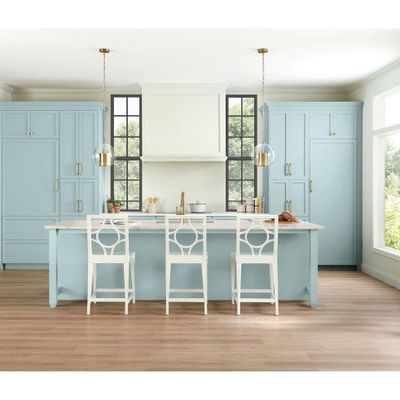Antimicrobial paint can kill bacteria, but do you need it to?

You can’t turn on the television, open a paper, surf the internet or enter the grocery store these days without hearing or reading something about antimicrobial this or antibacterial that. Soaps, sprays, wipes, food containers and fabrics are just some of the items that promise germ-fighting superpowers. Now there is another product to add to the list: paint.
Sherwin-Williams has developed a new addition for its SuperPaint line: SuperPaint with Sanitizing Technology. The Environmental Protection Agency-registered water-based paint is made with a patented technology that Sherwin-Williams says kills 99% of certain bacteria (including staph, E. coli, MRSA and VRE) that land on its surface within two hours of exposure.
The paint, which is available only in a satin finish (approximately $67 per gallon), joins Sherwin-Williams’ SuperPaint with Air Purifying Technology, which the company says helps break down unwanted odors and reduces volatile organic compounds, or VOCs, that emanate from household items like carpet, cabinets and fabrics, as a cornerstone of the company’s Living Well collection.
The paints in the collection are available in limited, light-color-only palettes that sound more like they belong in a spa than a hardware store – Recharge, Reflect, Balance and Breathe, among others. No doubt the company is appealing to customers’ heightened desire for health and wellness during the pandemic, but the new introductions are not a quick reaction to the coronavirus. These products have taken years to develop.
PPG also has been working on an antimicrobial paint. But although Sherwin-Williams adds antibacterial chemicals to its paints, PPG uses a technology developed by Corning that harnesses the natural properties of copper to kill not only bacteria but also viruses that lands on the paint’s surface.
Joydeep Lahiri, vice president of Corning’s specialty surfaces division, says the technology essentially traps the known antimicrobial properties of copper in a glass-ceramic matrix, which is then turned into a powder and added to the paint. Once mixed in, the powder is not noticeable.
PPG and Corning have been collaborating on the project for more than four years, but “with the COVID crisis, the relevance and interest in this product has exploded,” Lahiri says.
Although PPG’s paint is still awaiting EPA approval, Eric Stevenson, director of product management and marketing, expects that it will be on shelves by the middle of this year in more than 600 colors and several finishes. The cost has not yet been announced. He also says that product testing shows the paint’s antimicrobial properties will last up to six years, even with rigorous cleaning.
As promising as these paints sound, there are critics, including those who say that regardless of the paint’s ability to kill bacteria, it could focus people’s energy in the wrong direction.
“I don’t think antimicrobial paints are the key to preventing the spread of disease,” says Erica Marie Hartmann, assistant professor of civil and environmental engineering at Northwestern University. “Specifically, in the context of COVID-19, evidence points to viruses in the air being the main way the disease spreads. Paints won’t help with that.”
These paints don’t purify the air; they only kill the bacteria or viruses that come into contact with the paint’s surface. And as for spreading germs on surfaces, Hartmann says we should be more concerned with high-touch areas like doorknobs, elevator buttons and faucet taps than painted walls.
Hartmann also says that most bacteria floating around your home is not harmful, and, in fact, could be helpful. “One main problem with antimicrobials is that they do not distinguish between good and bad microbes,” she says.
The paints, she adds, “don’t even distinguish between viruses and bacteria, which is a pretty big biological distinction. So, in trying to get rid of viruses, we are exposing bacteria to antimicrobials. The more you expose bacteria to antimicrobials, the more likely they are to develop resistance, both to the antimicrobial itself and sometimes also to medically necessary antibiotics. Bacteria, which may otherwise be harmless, can thus become very problematic.”
Furthermore, bacteria don’t like dry, barren surfaces like painted walls, whether they’re painted with regular or antimicrobial paints, Hartmann says. “In our experiments, we saw similar levels of reduction in viable bacteria regardless of whether it was painted with a microbicidal paint, a regular paint or an all-natural clay paint. So whether or not your paint is killing the bacteria, they’re dying anyway.”
Her recommendation? If you are concerned about harmful germs on surfaces, skip the specialty paint and clean the surfaces regularly with a mild detergent.